Small breed dogs are very popular, but maybe they’re not your “jam”. If you’re someone that loves a dog that hogs the couch… and the bed… and is, more or less, the size of a small horse… then there are a few giant dog breeds with gentle temperaments, love companionship and, to put it bluntly, are just big teddy bears that may be a good match for you!
You may find this appealing and you may not… but many of these dogs are very loyal and protective of their family. Think about it… how intimidating would it be to someone coming on your property that shouldn’t be there… and seeing you have a horse-sized dog… it may make them think twice. Many of these dogs are intimidating looking (note I said “many”… I just can’t look at a Saint Bernard and think… “ohhhh, you’re so scary!” at least not without giggling!)… but are gentle giants at heart.
When considering a giant dog breed remember that everything will be on a large scale… and I do mean large! They will eat more (and “more ” is likely an understatement!) … and equipment you might use (leashes, seatbelts, harnesses, etc) need to be larger and more heavy duty. Then you have vet costs! Yup, those will increase…. and likely dramatically… too! And, well, depending on the dog, they won’t necessarily fit well in a tiny home (if that’s your preference)… and then you still have to wonder… will they fit in your car? Or will you need to remortgage that tiny home to buy a vehicle that fits your dog? Okay, so I may be getting a little carried away, but these are… or should be… considerations.
If you do love big dogs… and a lot of people do… the one real downside is that these breeds often have considerably shorter life spans than many other dogs… especially smaller breeds. Along with that they’re more prone to a number of health issues. These are all things that should be taken into consideration if you are looking to add one of these mini-horses giant dog breeds to your life.
Oh, one last thing… dogs this size ALL need to be trained (but here’s a little secret… ALL dogs should be… big… or small!) Training should start early… and include proper socialization. We’ve all seen small dogs with bigger than life attitudes… imagine a 150 to 180lb dog with serious behavioral problems. That’s a “giant” problem… not only for you, and those around you, but also for your dog. So, do yourself… and your dog… a favor… if you are considering a giant breed, do your research and find a professional dog trainer to work with. Start your life out together on the right foot… or paw! *stepping down from my soap box*
So, without further ado, here is our list of giant dog breeds… and I do mean giant! These larger than life dogs can make a great companion for you and your family.
Great Dane
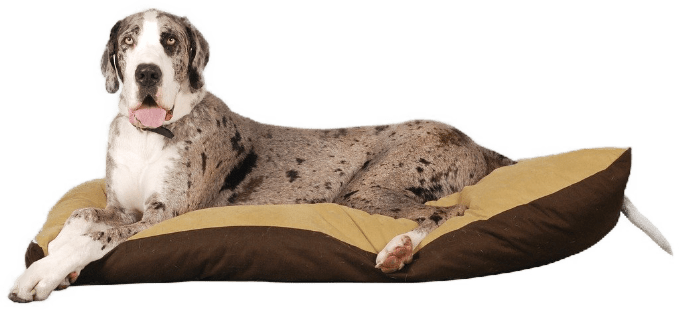
The easy-going Great Dane, often referred to as the “Apollo of Dogs”, is one of the tallest dogs in the world. Despite their powerful and daunting appearance, the Great Dane is an incredibly affectionate, gentle and social breed. They are an incredibly playful breed that loves children and prefers to be wherever their family is.
With their massive size and strength, as mentioned previously, it’s important to properly train and socialize a Great Dane. You don’t want to have a dog this size experiencing behavioral problems in adulthood! Though they have a tendency to have a bit of a stubborn streak, generally Great Danes are eager to please which will make the training process a fun and positive experience for all… particularly when using a positive approach to training. A little surprisingly perhaps… the Great Dane is a wonderful competitor in a variety of dog sports, including agility, obedience and flyball.
Because of their size you will find a Great Dane is much more expensive to feed than a smaller breed dog… but the extra costs don’t end there. Your average veterinary expenses will be higher and the wear and tear on both your car and your home will be higher as well. Overall, the Great Dane isn’t a cheap dog to share your life with… but the years that you spend with them will be filled with love and joy if you decide to add this gentle giant to your family.
On a bit of a side note… did you know that the Great Dane was designated the official state dog of Pennsylvania? Yup, in 1965. The legislature stated:
“… the physical and other attributes of the Great Dane, to wit: size, strength, beauty, intelligence, tolerance, courage, faithfulness, trustworthiness and stability exemplify those of Pennsylvania;…
Enough said!
Temperament: Friendly / Patient / Dependable
Height: 30 to 32 inches (male) / 28 to 30 inches (female)
Weight: 140 to 175 lbs (male) / 110 to 140 lbs (female)
Life Expectancy: 7 to 10 years
Newfoundland
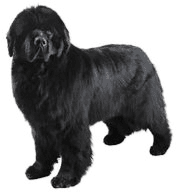
Newfoundlands, as you may not be surprised, were bred as a working dog… in… you guessed it… Newfoundland, Canada… which explains their name. For those that aren’t familiar with Newfoundland, it is an area in Eastern Canada that is surrounded by the Atlantic Ocean. Given that, it shouldn’t shock you to learn Newfoundlands are amazing swimmers… primarily due to their partially webbed feet. Newfies were often used as rescue and service dogs on fisherman ships.
The Newfoundland is well known for their sweetness, gentleness, and devotion, and they’re a great choice as a family companion. Often referred to as a “nanny dog”, children have a very special place in a Newfie’s heart. They are incredibly gentle with kids…. and have a strong protective instinct… but in saying that they are definitely not a “watchdog”.
With respect to their love of children, here’s a fun fact: J.M. Barrie, the author of Peter Pan, had a Newfoundland. In fact, his dog, Luath, was the inspiration for Nana, the Darling’s “nurse” dog, in Peter Pan… a story, and dog, loved by so many.
The Newfoundland can grow to over 100lbs during their first year of life! So in their first year they can actually outgrow the size of some adult humans! A dog this size eats a lot more than a smaller breed dog… which means your food bill for them will be much… much larger!
As far as grooming goes, the Newfie has a heavy, double-coat that requires a fair bit of maintenance. Ideally daily brushing is recommended, but if that isn’t possible it should be at least once a week to ensure they don’t have any mats or tangles. If starting out on the right foot with brushing your dog it can be a great bonding experience… and what big dog lover wouldn’t would enjoy spending time with such a gentle and loving breed.
Temperament: Devoted / Sweet / Patient
Height: 28 inches (male) / 26 inches (female)
Weight: 130 to 150 lbs (male) / 100 to 120 lbs (female)
Life Expectancy: 9 to 10 years
Saint Bernard

Originally, the Saint Bernard guarded the grounds of Switzerland’s Great St. Bernard Hospice but they also assisted in the task of helping to locate and rescue lost and injured travelers. This is how many of think of the Saint Bernard. We’ve all seen the breed depicted carrying a small cask around their neck and assumed it was filled with brandy to warm up those they have rescued, but what was actually in that cask was both food and water.
As a breed, Saint Bernards are gentle giants with a calm and relaxed demeanor. These characteristics, along with their endless patience with children – and other pets – make them a great choice as a family dog. Training a Saint Bernard, with their eagerness to please, should be a fun and positive experience for all, but, like other giant breeds, training should begin at a young age while they are small and easier to manage.
Is a dog that drools not your thing? If it’s not, this may not be the breed for you. With the unique shape of the Saint Bernard’s head, their jaw, and loose jowls, they have a tendency to drool more than other breeds. Many owners adapt and learn to carry a “drool rag”… but as a side note, this lumbering breed does have a tendency to drool more when they are hungry… overheated… or excited. Now, I don’t know about you, but that sounds like every category except sleeping! If you love the idea of a Saint Bernard don’t let a little drool prevent you from considering one of these lovable giants for your family. They will, many times over, make up for the messy inconvenience with their affectionate and playful personalities.
This is another breed that can get to be well over 100lbs in their first year of life – and eventually they will grow to a size in adulthood that is larger than many adult humans! An adult Saint Bernard can weight as much as 180lbs.
Grooming-wise, Saint Bernards have either a short or a long coat… and like all breeds, the longer coat will require more brushing and maintenance. Generally a Saint Bernard should be brushed multiple times a week (brush type varies depending on their coat) as well as keeping up with regular grooming tasks such as nail trims.
Temperament: Playful / Charming / Inquisitive
Height: 28 to 30 inches (male) / 26 to 28 inches (female)
Weight: 140 to 180 lbs (male) / 120 to 140 lbs (female)
Life Expectancy: 8 to 10 years
Mastiff
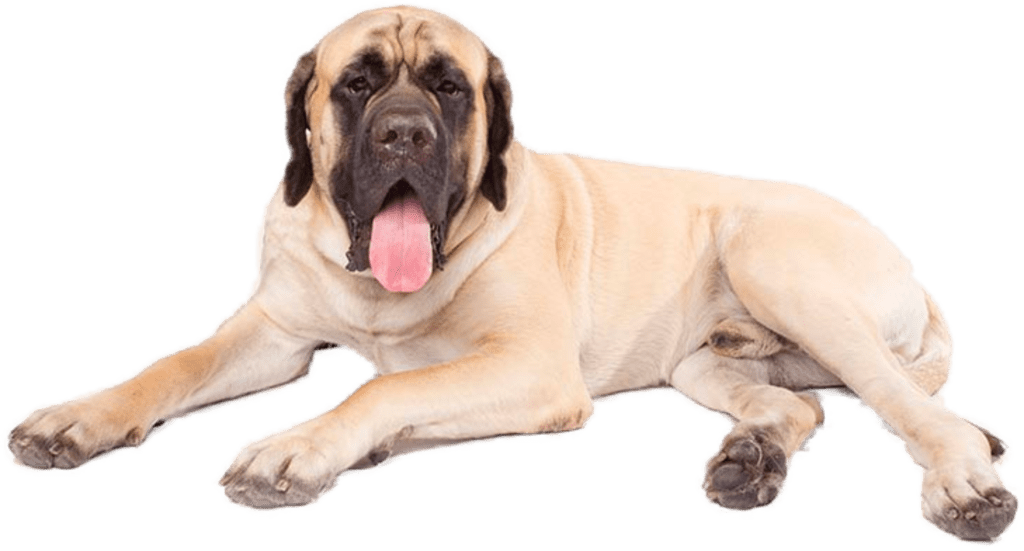
The Mastiff is a loyal and devoted breed that’s friendly and makes an excellent canine companion. However, the Mastiff is also a breed that is very vigilant around strangers and can be aggressive if they feel they need to protect their family or home. With family, they have a gentle heart and an eagerness to please the humans in their life.
Mastiffs have a short coat which is easy to care for, but to keep it looking healthy brushing once a week will remove any loose and dead hairs so they don’t end up around your house. Any skin folds should be cleaned daily to prevent skin irritations or infections from developing. They will leave a little more of a mess with their tendency to drool…. but their personality will make up for a little extra mess!
They have moderate exercise needs and are generally not known for their speed. They may be a little slower on their walks… but they move with purpose!
The Mastiff is no exception to the rule that all dogs should be trained… and at an early age… beginning with socialization. They are very intelligent but do have a stubborn streak. You may find that they become bored with repetition in training… so keep training short and fun to hold their interest. You may not think it to look at them, but they can be sensitive, so using positive training methods would be your best choice. Using aversive methods could lead to distrust and fear… which is not good in any dog… but especially not in a dog of this size. There are many recommendations out there that this is not a breed for first time dog owners.
Temperament: Dignified / Good-Natured / Courageous
Height: 30 inches and up (male) / 27.5 inches and up (female)
Weight: 160 to 230 lbs (male) / 120 to 170 lbs (female)
Life Expectancy: 6 to 10 years
Dogue de Bordeaux
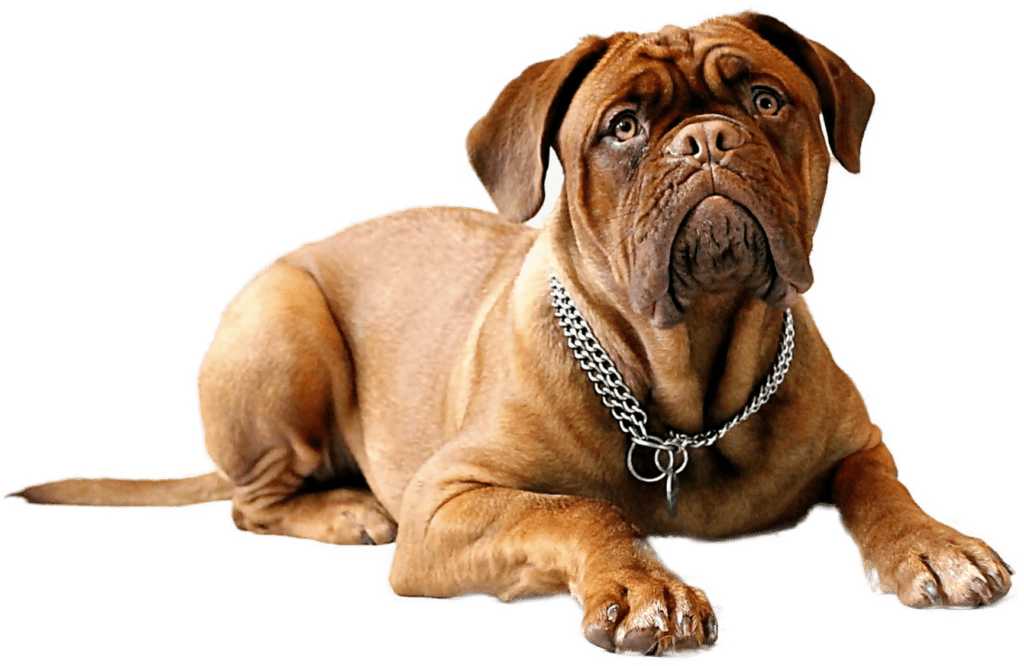
Originally from Southern France, specifically the Bordeaux region (thus their name), the Dogue de Bordeaux was initially used as a guard dog for elite homes. Today, the Dogue de Bordeaux is generally a calm, affectionate dog who is deeply devoted to their family, making them an excellent companion. They do however, still carry that protective instinct and will courageously guard their family and property.
Eager to learn and please their humans, socialization, paired with positive training, should start early in life as this breed can easily become bigger and stronger… and more stubborn… than many human companions. This may not be the best choice for first time dog owners. Be aware that the Dogue de Bordeaux isn’t always willing to share their home with other pets.
This breed gained a lot of popularity after Tom Hanks’ movie, Turner and Hooch. Anyone remember the scene where the Dogue de Bordeaux ate the interior of Tom Hanks’ car? My favorite scene! And, if you are familiar with that movie, you would also know that these dogs drool… a lot! Drool everywhere… the walls, the floors, the furniture, the car…. everywhere!
They do have a short coat so grooming needs are minimal. Brushing weekly and bathing every few weeks should suffice, but their short coats don’t provide a lot of protection from weather… hot or cold… so outdoor exposure should be limited during temperature extremes. Any skin folds should be cleaned daily to prevent skin irritation and infections from occurring.
Unfortunately, like many giant breeds, they have quite a short life span and are prone to health problems… a consideration that should be noted before adding one to your family. There are those that say with proper veterinary care, regular exercise (they have a moderate energy level) and ensuring that you are feeding a high-quality diet, their life can be extended. Who wouldn’t want to do all they can to extend the time they have with their dog?
Temperament: Loyal / Courageous / Affectionate
Height: 23 to 27 inches (male) / 23 to 26 inches (female)
Weight: 110 lbs and up (male) / 99 lbs and up (female)
Life Expectancy: 5 to 8 years
Great Pyrenees

The Great Pyrenees was originally bred to be a livestock guard dog… but they were not just a guard dog… also a guardian. Great Pyrenees are known to protect members of the flock, but also care and nurture them. Their instinct is to be kind and patient with all… this makes them a wonderful companion for families as they will also get along well with other pets in the home. It is interesting to note that they are naturally nocturnal as they were bred to guard the flocks at night while the shepherds were sleeping.
Great Pyrenees have a heavy, double-coat, which allows them to withstand harsh winter winds and cold temperatures. This makes them a little less suited to warmer climates. Their coat is usually solid white in color but can also have reddish-brown or gray markings. The Great Pyrenees will require regular brushing… aim for at least 30 minutes once a week to ensure they have no mats or tangles in their beautiful coat. Even better, brush them daily for optimal maintenance. Like other double-coated breeds, do not shave the Great Pyrenees… even in the summer. Their coat serves to keep them cool in the summer and warm in the colder months.
Being a high-energy dog with a high prey drive, Great Pyrenees are not well adapted to apartment life… or being solely an indoor dog. They need, and love, to have a big space to roam and they will thrive in a home with a backyard or garden to spend time in the outdoors. In saying that… they also do like to be with the family and don’t do well being left alone for long periods of time… but what dog does really?
Traditionally the Great Pyrenees is used to working and thinking on their own – a characteristic that is still strong in the breed today. This can make training a little more difficult, but starting early and using positive training methods with a focus more around kindness, consistency and giving the dog some choice… can make training easy and fun,
Did you know that a Great Pyrenees named Duke the Dog actually became the Mayor of Cormorant, a small town in Minnesota, US, in 2014? Mayor Duke he was called… and served at least three terms as Mayor! I think I found the next place I want to move!
Temperament: Smart / Patient / Calm
Height: 27 to 32 inches (male) / 25 to 29 inches (female)
Weight: 100 lbs and up (male) / 85 lbs and up (female)
Life Expectancy: 10 to 12 years
Irish Wolfhound

May may think of the Great Dane when referring to the tallest dog… but the tallest breed is actually the Irish Wolfhound, by AKC standards. Standing up to a minimum of 32 inches at the shoulder, the Irish Wolfhound may be 7 feet tall if standing on their hind legs. Now that’s tall!
The Irish Wolfhound was bred to hunt large game in the Irish countryside… primarily wolves, wild boar and deer. A hunter they are… a guard dog they are not. They are very likely to make friends with a stranger in a matter of minutes… providing the stranger is comfortable with giant dogs!
This is a breed that can be a great companion for families… though care should be taken around small children as the Irish Wolfhound can very easily, due to their size, knock over a small child when excited.
Though their exercise levels are moderate… they are completely happy snuggling up with you on the couch… or just chilling around the house if the weather isn’t suitable for being outdoors. As a sight hound, on walks, it’s best to keep them on a leash. Long before you do, they can spot something and be off on the chase… and with their strong prey drive you may find it very challenging for recall.
Irish Wolfhounds have a thick, double-coat, with their top coat being more wiry than soft. Brushing them once a week will help ensure that their coat doesn’t get matted or tangled… and keep it well maintained.
Overall, they are intelligent and they are quick learners… making them relatively easy to train. As with all dogs, positive reinforcement training should be used, allowing you to build a strong relationship between you and your dog. Whether or not they get along with cats and other pets will be very specific to the individual dog, but proper socialization and training… along with working with a professional trainer… will be your best bet to ensure success… and if they can’t get along a trainer can help you understand how you should manage it.
If you are looking for a calm, gentle and kind giant breed… the Irish Wolfhound should be one that is worth considering.
Temperament: Dignified / Courageous / Calm
Height: 32 inches minimum (male) / 30 inches minimum (female)
Weight: 120 lbs (male) / 105 lbs (female)
Life Expectancy: 6 to 8 years
BullMastiff
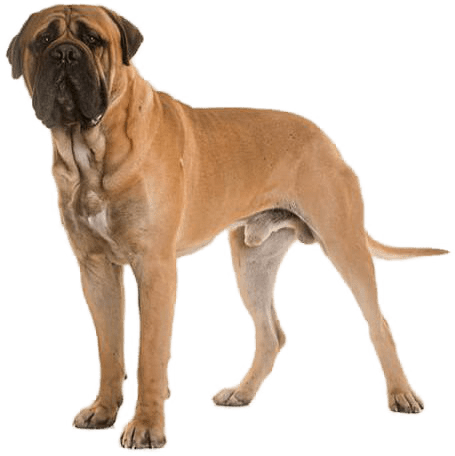
The Bullmastiff, bred by crossing a Mastiff with a Bulldog – thus their name – was originally a guard dog for wealthy families in England. They were bred to be a different kind of guard dog than what you might think. The Bullmastiff was trained NOT to bark or bite intruders. Nicknamed the “silent watchdog”, they were to covertly track intruders and then pin them down without mauling them… their only task was to apprehend them. This unique instinct has remained within the Bullmastiff today… leading to a dog that will still occasionally bark, but not nearly as frequent as other breeds. This can make them a good fit for apartment life as long as they are still getting exercise to meet their moderate energy level.
The Bullmastiff is a very large, muscular dog and for many, may look intimidating… but they have a gentle heart. Both loyal and obedient, a Bullmastiff that is properly trained can be extremely laid-back. They can make a good family companion, but with a dog this large small children should be supervised to avoid any unintentional accidents due to the dog’s size.
Bullmastiffs have a short coat, which should be brushed weekly and any skin folds should be cleaned on a daily basis to avoid skin irritations or infections. Like so many other giant breeds, the Bullmastiff is well known for drooling so keeping a towel to clean up the drool will not only help to keep your house less messy… but also your dog.
Sadly, the life span of the Bullmastiff is less than 10 years and they do suffer from a number of health problems. These include bloat, hip dysplasia, breathing problems and eye issues. These should all be factors that are taken into consideration before adding one to your life so you are prepared to support any issues that may come along.
Though Bullmastiffs love their human companions they don’t always love cats – or other dogs for that matter… something else you should be conscious of if you have another pet in your home. Overall the Bullmastiff is a big, lovable breed that would make a wonderful companion for families, and individuals alike.
Fun fact… likely the most famous Bullmastiff would be Sylvester Stallone’s family dog, Butkus, who was actually used in the movie Rocky as Stallone was unable to afford a trained movie dog.
Temperament: Loyal / Affectionate / Brave
Height: 25 to 27 inches (male) / 24 to 26 inches (female)
Weight: 110 to 130 lbs (male) / 100 to 120 lbs (female)
Life Expectancy: 7 to 9 years
Neapolitan Mastiff
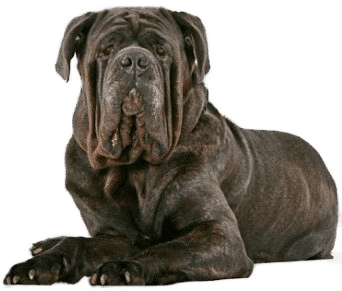
With their massive size and muscular build, the Neapolitan Mastiff are another breed that may seem intimidating, but the fact is they are a loving companion. Like many other giant breeds they are a protective and powerful breed that makes it very clear to strangers or intruders that they are not welcome near their family… or their home. With their strong-will they are not a breed that is recommended for first time dog owners. Training should start, like all dogs, at a young age while they are still “small” and more manageable.
As puppies, the Neapolitan Mastiff has blue eyes and as they grow they change to a dark brown color. In the puppy stage Neos are fairly active but as they mature the energy level of an adult Neapolitan Mastiff is more in the moderate range. They may not require a lot of exercise but they do enjoy the outdoors. When not outdoors however, they equally enjoy finding a cozy place in the house to chill. They are not an elegant or graceful dog and therefore can easily wreak havoc, unintentionally, in the home…. therefore better suited to a larger living space… for their sake and yours. Along with this fact, supervising smaller children in their presence is important (as it really is for all dogs and children) to avoid this giant dog accidentally knocking over a young child.
The Neo can drool… and drool a lot! You will likely find a trail of drool wherever they go… your floors, the walls and the sofa! (I feel like I should be writing a Dr. Seuss book about this!) It is not a bad idea to keep a towel handy to help keep the drool from making a mess. If you are a “neat freak” this may not be the breed for you… but that is the case for many of the giant breeds.
They have a short coat which comes in gray, black, mahogany and tawny. Grooming needs are relatively low… weekly brushing to remove any dead hairs… but daily they should have their skin folds cleaned to prevent any skin conditions or infections.
Temperament: Dignified / Loyal / Watchful
Height: 26 to 31 inches (male) / 24 to 29 inches (female)
Weight: 150 lbs (male) / 110 lbs (female)
Life Expectancy: 7 to 9 years
Leonberger
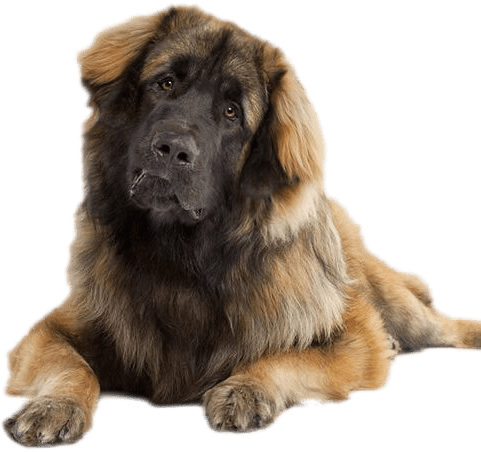
Originating from Germany, the Leonberger was bred specifically to resemble a lion… but I would say they look like an awfully cuddly lion if that is the case! Appearance-wise they are known for a medium length coat and bushy tail… the traditional black face mask… and the male’s coat has a lion-like mane around their neck and chest area.
Leonbergers are a high-energy, friendly dog that need room to run, but also love to spend time with family getting lots of love… which they will gladly accept! With their sensitivity and need for being around their human companions, they may not be the best choice if you are having to leave them alone for long periods of time. They are great with children and the elderly as they have an excellent “bedside manner” which you may not think of with the size of the Leonberger. They are also generally good with cats and other pets.
Their energy level would be in the moderate range. If you are not up for a little more active dog this may not be the best choice for you. Leos do however enjoy a variety of activities including long walks and hikes and, due to their webbed feet, swimming.
With their eagerness to please their humans training shouldn’t be too difficult. They will however respond best to positive training methods. Be kind, patient and consistent and training should be a fun experience for both you and your dog.
As far as grooming and maintenance goes, if you don’t want a house covered in furry dust bunnies… their thick, double-coat will require frequent brushing… daily is best, but a good weekly brush-out at minimum. Drool is also something that you will need to contend with… but their gentle and playful personalities should make up for any mess they may make in that regard.
Unfortunately, like many of the giant breeds, the Leonberger’s life span is not very long and they are prone to a number of health issues.
Temperament: Friendly / Playful / Gentle
Height: 28 to 31.5 inches (male) / 25.5 to 29.5 inches (female)
Weight: 110 to 170 lbs (male) / 90 to 140 lbs (female)
Life Expectancy: 7 years
Personally, I LOVE big dogs… the bigger the better! On this list, do I have a favorite? Yup… any of the dogs that are big and fluffy… oh, and the Great Dane! But seriously, the Saint Bernard has been a breed that I have wanted to add to my family… but, I am also very aware of the financial commitment as well as the space needed. So, let’s just say, spending my life with one is on my bucket list and when the time is right I look forward to it! I only wish these giant breeds lived longer… they have so much love to give, their time in our lives is not long enough.
So… if you are a giant dog lover (and I am assuming you are if you are here reading this)… what is your favorite breed?

credit: AKC Stats


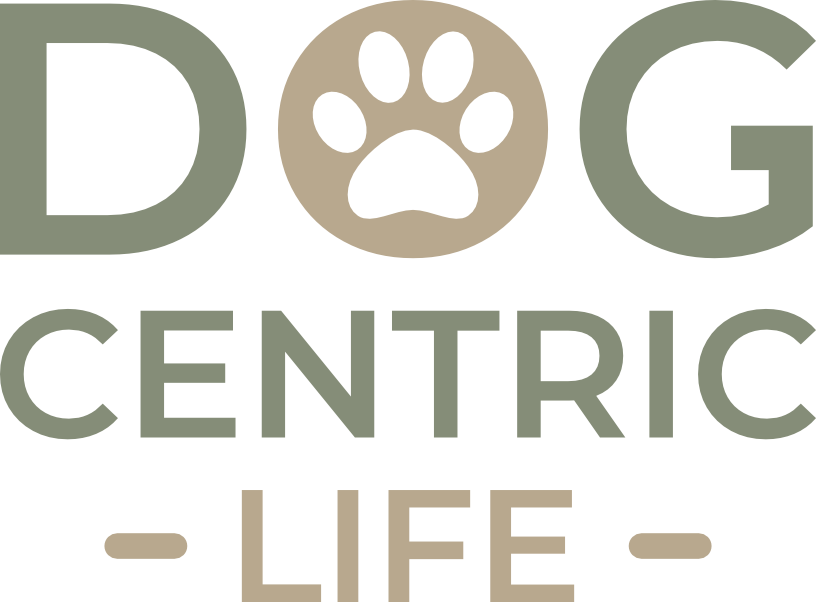



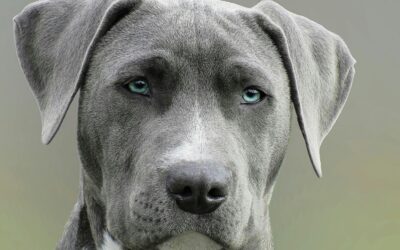
0 Comments